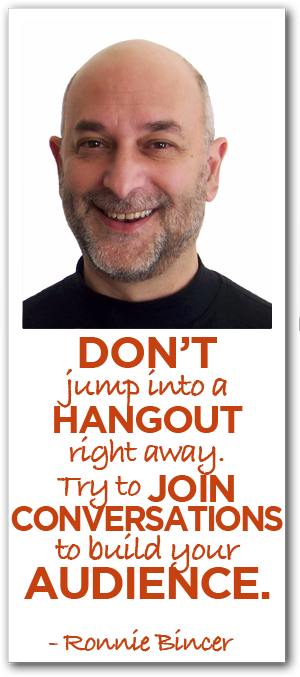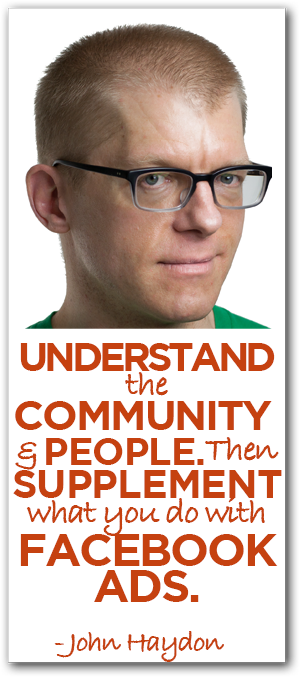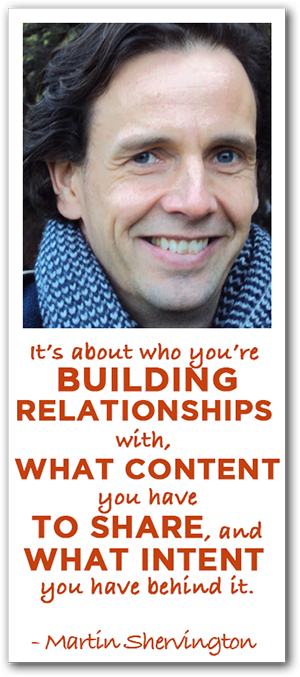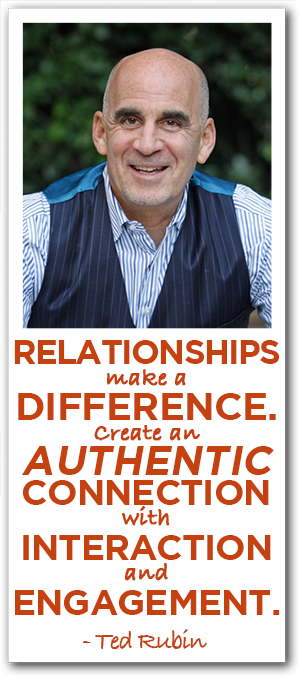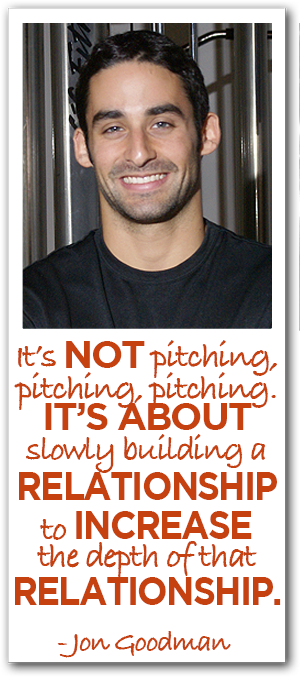 Did you know personal training and self-motivational techniques can help you strengthen your small business? Do you know how to maximize Facebook comments to re-animate old blog posts and generate new streams of revenue?
Did you know personal training and self-motivational techniques can help you strengthen your small business? Do you know how to maximize Facebook comments to re-animate old blog posts and generate new streams of revenue?
If not, then you’re not alone. A lot of small businesses don’t know how to motivate themselves to tackle big projects let alone motivate their clients. By breaking out your big projects into smaller pieces and then creating a reward system when you complete each step, your tasks will be much more palatable. This week, we talk it up with long time personal trainer, owner of PTDC (Personal Trainer Development Center), author, and social media maketer, Jonathan Goodman, to learn more about how to push through tough goals and make the most out of what our core talents are.
Podcast: Play in new window | Download
Subscribe: RSS
Big Ideas:
Jon, you started out as a personal trainer. How did you end up becoming the guy behind the Viralnomics blog and basically running your own small social media empire up there in Toronto?
- It’s a very long winding tale. I was a personal trainer and I saw a need for how you get somebody to want to do a workout and adhere to a workout better which stems mostly from psychology than it actually does any kind of physiology or biomechanics.
- So I started doing a lot more research into the psychology of adherence, even word of mouth and social contagion theory when I was in training for marketing purposes.
- As I wrote my first book, Ignite the Fire, I decided I needed to promote the book using a website and that’s where the PTDC (Personal Training Development Center) came on and social media was, and I believe still is, to promote a blog through word of mouth.
- I took a lot of the same theories that I was using to try to get clients to speak about me and just applied them to whatever social media networks I found to be the most effective at the time; Facebook being the biggest one.
- The result was uncanny and I started doing nominal research and started getting in touch with John at University of Wharton School of Business as well. I started to really expand upon those theories and that’s how the Viralnomics blog came about.
In a lot of industries you sort of hit this glass ceiling. There’s only so many hours in the day you can make money, so you have to branch out. Was that part of what was going on as well?
- That was 100% of what went on and that was a huge issue for me at 23 years old. I had kind of hit what was known to be the highest income level for a personal trainer working in downtown Toronto. I was making $100-$120 an hour and I had anywhere from 40-50 contact hours a week which for anybody that knows personal training means you work anywhere from 60-80 give or take.
- I was also managing a group of trainers at that time and making a bit of a salary from that so really my only options were to own a gym which I felt and still believe for most people is a fool’s proposition. Or, to sell things like supplements and all of these multi-level marketing schemes which is something that I fundamentally don’t believe in.
- I started to read up a whole bunch about multiple streams of income, passive income, income generation and all that fun stuff. Eventually I came across the term “infopreneur” and that’s how it all started.
How did you segue into doing multiple streams of income? What were the steps? Can you tell us a little bit about how you carved out time in your day and what research you did?
- Carving out time in the day is a good point to hit on. I’m glad you spoke about it. Actually I had a number of very good mentors because of where I worked it was a very affluent neighborhood and one of my clients was the dean of medicine at University of Toronto. Another one was the head of psychiatry at one of the major hospitals in Toronto.
- So I have some very high-level, very well educated, just incredible people who were mentors to me who were my clients. One of them gave me this principle that I later called the “freedom number” and it became the basis for one of the courses I put out.
- It’s very basic. Pretty much it’s just this equation for establishing what amount of money I need to make to make sure all of my basic needs are looked after. That’s of course my food and rent, but it’s also if I have dependents. I call it “do something special for the girlfriend” fund. What is it you actually need each month?
- At the time, all I needed was $2600 a month. I didn’t have dependents or anything like that, so it was quite low. So then I took a look at how much money I was making each month and I actually whittled down my clientele to eventually 15 hours a week (and this is from 40-50 previously).
- I first went to 25 and kind of cut out all of the sort of wishy-washy clients that personal trainers have. Then I cut it down to 15 and very much condensed and organized and made my schedule much more efficient and I started to block off times for personal development and I started to block off times for writing throughout the day.
- That, I will say, is by far the most important thing I ever did. Was take a really strong step back and say, “how much money do I really need to make? How can I make that in the most efficient way possible over the course of my day so that I can focus on building assets?”
- The first asset that I focused on was this huge project was this book, Ignite the Fire, that took eventually three years to put out. The book was fortunately well received but if I were to do it again, and I spoke to a personal trainer the other day and this goes for pretty much any industry where there’s a service need (like plumbers for example), building up an asset for a business that is just a passive income stream is actually really easy to do.
- In terms of just packaging what you know over the course of a day is as simple as walking around with a clipboard and writing down notes of all of the little tasks you do over the course of a day and putting it together in a 20 or 30 page guide or workbook.
- You can put this thing out for $4.99 or $9.99 as an ebook. I put one out about three weeks ago that was about 125 pages. It was a compilation of a bunch of things. I put it out for literally zero dollars. I didn’t even create a cover for it and used PayPal so it doesn’t cost me anything unless people buy it.
- So, I think anybody in any industry can do that and to get started and start seeing potential of producing these high-value but these short, information rich resources that act as an asset for that business.
As a personal trainer, what were some of the techniques you used to get your clients to behave in a way that helped you but more importantly helped them to succeed?
- I think that there’s two separate things at play.
- The first is kind of away from personal training specifically and more in this idea of creativity and the theory of creativity which is a fascinating area of study for me right now. There’s a psychiatrist who’s name is Rollo May and his book is absolutely fascinating and he’s one of the few academics who writes material that people like me can understand. One of the most interesting facets of his theory of creativity is understanding why it is that people who are inherently creative never actually see their projects through to fruition.
- This is something that I’ve fallen prey to and it speaks to a lot of people as well. Where by you have this great idea and you take all the actions to do it, but the minute there’s that time to flick the switch and actually ship it, as Seth Godin says, people eventually run the other way.
- His argument is saying, “what are the benefits and gains that somebody is getting from creating?” And often it’s not actually producing whatever the output is that they want to produce. Say it’s a book for example. Often it’s not that, there’s something much deeper. The example he gave in one of his books is that it’s his need to get acceptance from his mother. So, the minute that his mother says, “oh, that’s a really good idea,” all of a sudden his motivation wanes.
- What I think is really interesting about that concept is saying, “well why is it that you’re actually creating?” Money is a good motivator to a certain extent, but money is ultimately a really poor motivator once that person becomes comfortable with their living and once all their bills are paid and the people they love are looked after.
- So what is it that’s actually motivating you? Is it ego? Maybe. But again, where does that ego stem from? I think the first thing to understand is to be really honest and say, “why am I doing what I’m doing?” and, “who am I trying to please?” then you can kind of shift your work process into pleasing those aspects and being happy and fulfilled from that because fulfillment is really what’s important.
- When it comes to working out though, and I think it’s important to discuss the nature of procrastination. There’s a quote that I really love that says, “procrastination is opportunity’s natural assassin.” What that really hits on is procrastinators are addicted to what’s called immediacy. Meaning that the reason why most people don’t accomplish this huge task in the future like getting in shape, is because a lot of the things that are really great to have, to own, to be in this life have almost a punishment to get there a lot of the time. But, once we get there there’s this goal in sight a long way away. But, there aren’t rewards built into the process.
- I think that’s the most important thing. If you can build rewards into the process while achieving some major goal in the end, then those rewards become gratifying and they’ll help you accomplish that large task.
- The simplest example is in my second book, I actually split it into 82 cue card. Each cue card was one hundred words. Each cue card was a sub heading. The cue cards all sat on the right side of my computer I’d pick one up and write out that section of 300-600 words – it’s not as daunt ing as 3,000-5,000 word chapter – and when I’d finish it I’d pick up the cue card and physically put it face down on the other side of my computer.
- That tiny habit, that little reward and the gratification that I got of knowing that I completed a section and to pick it up and put if face down on the other side of the table allowed me to finish the book. And I knew that when the cue cards were done the book was finished and went off to editing and all the people who are good at that kind of stuff.
- So, anything that I think is really worth achieving is a matter of breaking it down into its fundamental pieces into manageable chunks that are 20-30 minutes of time each and providing some sort of reward for achieving that little chunk – and it could be as small as flipping a cue card over.
So, this is great, introspective advice for an individual, but what about when we’re trying to motivate our clients? Are there ways that we can show them or motivate them when we’re the outside source? What do we do then?
- I think you need to be a little bit more creative then. Going back to working out, there’s a fantastic program company called Fitocracy, and I’ve been good friends with the founders for years and they’re at like 1.5 million users now based out of New York, and they use gamification techniques.
- You have a status bar and you can level up and get points for the exercises you do. Every workout that you do you put in your workout, you get points and you see your status bar go up and up and other people you’re connected to give you props. The like button is props, and the picture is two knuckles.
- If you can build something into your business like that when a user updates a Facebook page, then they can go into the backend of your system and they say, “yes I updated my Facebook page,” and they put a little check in a box or something like that and then you could build out almost like a token system and that token system is a certificate, sort of like Weight Watchers. Where, if they do it ten times then you send them a gift in the mail.
- I mean, it would be different for everybody but it would be helpful for people to go in and show off that they’ve done something.
- It’s also important to consider tangible vs. non-tangible rewards. Something that somebody can physically hold in their hand and they say, “I have this because of this,” is generally for most people going to be a more powerful reward than something else.
- Also, what also needs to be considered is this nature of “third drive,” illustrated by Daniel Pink in Drive, but the research goes back to the 1950s. From that you look at the difference between tangible and non-tangible rewards and extrinsic tangible rewards can be powerful but they can also be damaging to intrinsic motivation.
- In the end you want people to become inherently intrinsically motivated and going forward the task becomes its own reward.
Jon, you and I had talked via Skype a few weeks ago and I couldn’t remember how we met. It’s actually an interesting story. Would you be willing to share how we met?
- A little while back I thought I wanted to get more into the social media marketing space. I’ve decided now to kind of write about that stuff for fun as a way to explore my own thoughts and actually market it but I thought that I wanted to become more notable in that space and go on the speaking circuit and write books about it and all that fun stuff.
- So, I identified five or six people that were in positions that I aspired to be in – social media marketers, people with popular blogs, people based on an idea, number of metrics, whatever – were in positions that I wanted to be in.
- Then I went and searched, and I had an intern at the time, we both went and searched for articles that had been written about them in major websites and major magazines. Then my targets were not these influencers because they’re so busy and they generally don’t care that much and there’s what I realized later on was there’s a bit of a focus group and a monopoly that they formed trying to almost have a net and choose who they bring in and who they don’t. But anyway, I didn’t want to be a part of that.
- But, Rich you were one of the people who were written in a number of articles written by these people that I aspired to be in their position. So I started to then try to figure out what social media or medium has the least amount of friction in Rich’s life. For Rich, it was Twitter, and for most people it’s Twitter.
- Twitter is a very good networking medium. Facebook is either very personal or business-y. Instagram is kind of tough because people don’t pay much attention to it. Pinterest is Pinterest, again it’s not very good. And LinkedIn, I don’t really see the benefit of it for networking beyond looking for jobs and head hunting. Although a lot of people disagree with me.
- Then it became a matter of finding all of these people’s Twitter accounts and just over a period of time building a relationship with them. I mean intelligently responding to their tweets. If they had an article, reading the article and maybe giving some sort of input. And looking for an opportunity to enhance that relationship.
- For Rich, it was I think you had asked a question? And I had just written something about it and we kind of had a unique viewpoint with it (at PTDC, my other business) and I so I just shared that with him and immediately he got back and said, “hey let’s jump on a call and talk about this.”
- So it’s not pitching, pitching, pitching it’s building a relationship slow enough and looking for an opportunity to actually increase the relationship with that person. With Jonah Berger it was that he had a book coming out and so after five months of tweeting back and forth with him I sent him a message and said, “hey, if I buy a copy of your book can you give me an early copy and I’ll write a review of it?” From that we were able to build a better relationship.
You love using Facebook comments for you blog. Can you share with us what exactly that makes Facebook comments a good solution for you?
- Right. It can be very very interactive. You can have people watching in the audience and asking questions live and you on the inside can see those questions with the tools you’ve got. You can even bring those questions right onto the screen if you want which I think is very very engaging with the audience and it’s live!
Let’s say I’m a small business owner, I do my broadcast, it automatically goes to YouTube. What easy things can I do to get people to find and watch my Hangout on Air up on YouTube?
- The question wasn’t about Facebook comments, I remember it now. The question was about how you get your old blog posts new life. I had sent you an example of a blog post that I’d written in November of 2011 that I had reshared. This is like three months ago, so like February or March of 2014. I had showed you an example of how I reshared that blog post on my Facebook page and got 12,000 views to it in a day and a half just by resharing it and using the system of Facebook commenting.
- I’ll try to be as brief as possible about this. Pretty much my view on comments is that people on the most part on Facebook and blogs don’t really care about adding that much more to the conversation.
- People read blogs to reaffirm what they already now. Fort the most part, people aren’t actually tribe or community members, your quality readers aren’t actually learning that much necessarily from your blog. They’re going there because it reaffirms what they already know and they’re going there because it gives them an opportunity to articulate their own thoughts better than they could perhaps do or have time to do it to their own audience.
- In commenting, what they’re doing is they’re commenting to almost boast to the abyss or tell you that you’re stupid – which I get is a form of boasting by saying, “hey, I’m smarter than this guy,” – so I really don’t like comments. I find that for the most part on blogs they’re a waste of time now. Five years ago I think it was different.
- So I decided to eliminate comments on the PTDC blog, but when I did it again I said, “maybe I can get an added benefit with these comments by using them not necessarily to stimulate discussion but using them to take advantage of Facebook’s story bumping feature to get new life out of old blog posts.
- What we did is we took the embed feature for a status update. So, we create a status update promoting an old blog post, put it on our Facebook page and then we’d actually embed that status update right to the bottom of a blog post and say, “hey, join the discussion. Comment below on the Facebook status update.”
- What this did was accomplish two things. First of all, it makes the entire conversation for the article take place on our Facebook page as opposed to the general Facebook comments you embed where the conversation takes place on your website but really on individual threads on everybody else’s Facebook page.
- What it also did, most notably, and where we’re seeing the biggest benefit now, is Facebook came out with this story bumping feature whereby you could have a status update from a few years ago, if there’s new comments on it all of a sudden it will pop up in a feed to a whole bunch of people that are relevant to other people based on their edge rank (which is a conversation for another day).
- What we’ve been doing is methodically sharing old blog posts, taking those status updates, embedding them to the bottom of these old articles, and then as people go through the archives and like a status update that’s embedded at the bottom of that blog post then all of a sudden now that status update on our Facebook page gets shown to all their friends.
- It’s just this perpetual system of old blog posts getting seen by new people interested over the course of a day. I can’t log in to Facebook and see any less than 20 or 30 notifications on our Facebook page. It’s because there are so many notifications happening on old status updates.
Which Facebook page is this that we’re talking about now?
- This is the Personal Trainer Development Center. Facebook.com/theptdc
I guess you could argue that any blog could benefit from Facebook comments.
- Yeah, and I agree with you. I mean we’ve been using it and having extraordinary success both with the growth of our Facebook page, but more so the growth of our email list.
- I still do believe that everything is about the email list. I don’t think Facebook is going anywhere. Facebook has kind of become that comfortable place and any reasonable competition they have they’re pretty much buying up. You could argue that Instagram is the young kids’ Facebook. Well, Facebook owns Instagram.
- I don’t think that Facebook is going anywhere. Even if they do right now Facebook is the best place in the world, and I don’t think you’d argue with me here, to gather people who are interested in a subject in one place, create a community around them, and create enough value with them that they become interested in your more premium materials to opt in.
- We share on our Facebook page a squeeze page from Facebook once a day or every other day and as a result our email list grows 200-500 people every single day. Just from our Facebook page.
- It’s because we’ve built up so much relevancy with our Facebook page on a continual basis that on a Facebook page of 81,000 people a squeeze page will get seen by 30,000 every single time we post it.
Juicy Links:
- Get in on the early bird discounts for Agents of Change!!
- Check out the PTDC Facebook page.
- Check out the PTDC website.
- Check out the Viralnomics blog.
- Connect with Jon Goodman on Twitter.
- Get a copy of Jon Goodman’s book, Ignite the Fire.
